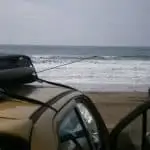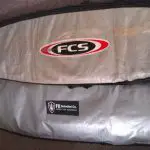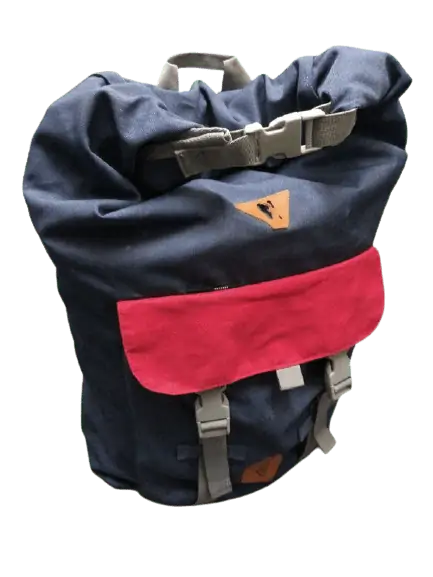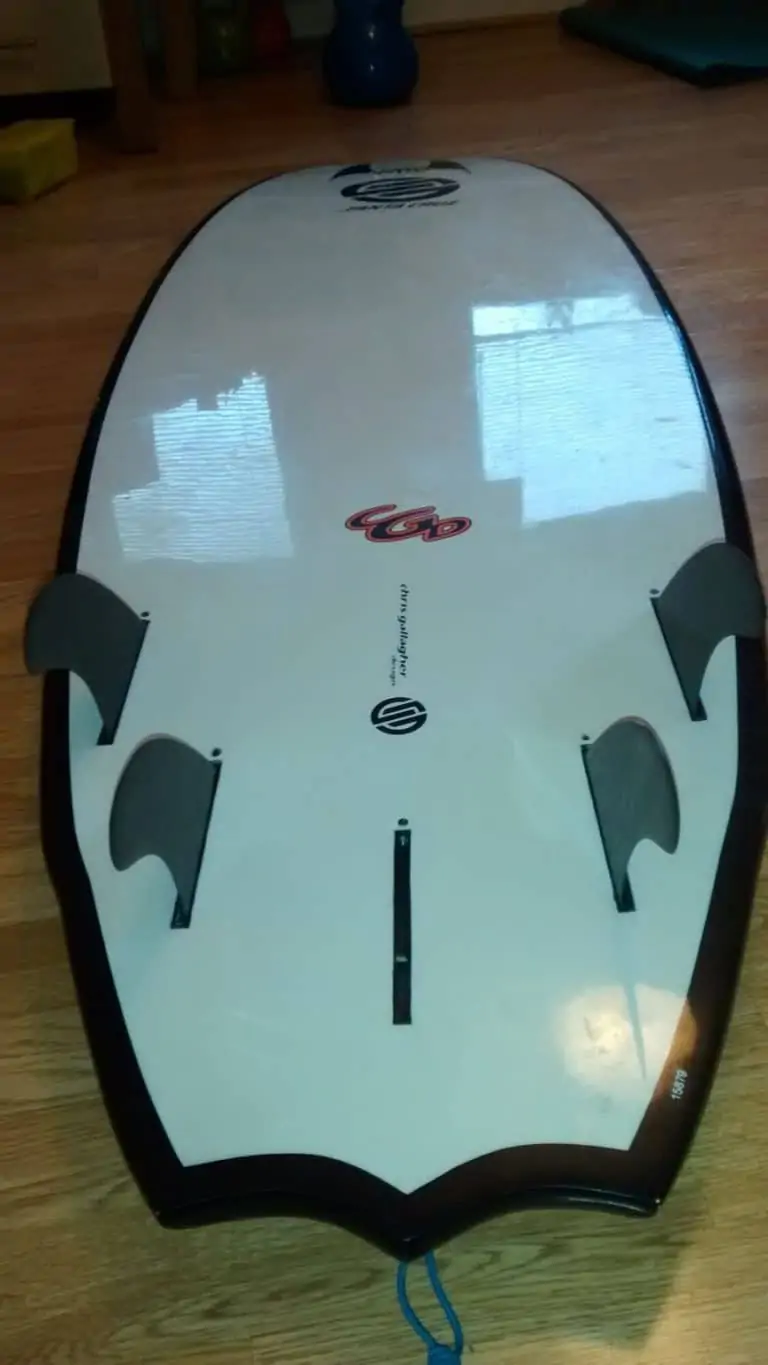How to Carry a Surfboard on the Roof of Your Car: Full Guide
Getting to and from the beach to go surfing is easiest done by car, but not all cars are well suited to carrying surfboards in.
The obvious option then is to put your surfboard on the roof of your car since the inside has limited and awkward space. For people who have not done this before, there is a clear issue with putting a surfboard on top of a car, which is as follows:
How do you carry a surfboard on the roof of your car? Get soft racks from a surf hardware brand, attach these to your car and put your boards (in bags) on; tighten the straps and away you go. You can take soft racks on and off a car in minutes making them the best option, with more on this below.
For a more permanent option, fit metal roof racks from a reputable brand and attach your board to the rack with tiedown straps that have camlocks. It’s worth noting that these look ugly and any roof racks increase fuel consumption, so think carefully about this option.
The main point for both roof rack systems is to loop the tiedown straps around the boards and secure them in place, while also protecting the boards against damage, as we’ll explain below.
Now that we’ve run through the answer in brief, let’s look at this in more detail to get you and your surfboards to the beach by car without any issues. Let’s jump right in!
How do you tie down a surfboard on a roof rack?
The main way to do this is with tie-down straps that are designed for a roof rack. These will have a ratchet that can be tightened around your surfboard to make sure it is securely attached to your roof. The key steps are as follows:
- Place your surfboard(s) flat on the roof of your car facing forwards, meaning you have the surfboard fins to the back of the car
- You should also point the nose so that it is curved downwards
- Put the boards so that the the middle of the board is in the middle of the roof lengthwways
- About one third of the way down the board from the nose, pass one end of the tiedown straps over the top of the surfboards and pull it around to make a loop and pass it through the camlock buckle. Repeat this for the lower third of your boards, too, with the tiedown straps evenly spaced on your surfboard(s).
- Exactly how you do this depends on the type of roof racks you have
- Pull this tight so that the boards don’t move up and down
- Don’t go too tight here as this could damage your surfboard
- Tie up any loose ends to avoid annoying the driver
Cross Bar Roof Racks
Cross-bar roof racks do work with surfboards but they are a bit more tricky to carry surfboards than with the surfboard-specific soft racks.
With the metal bars that run horizontally across the roof of your car, these bars are raised slightly and can have all the straps on the outside of the car.
To tie your board to cross bar roof racks, you will want to loop the straps around the racks several times to get a good
Soft Racks
Soft racks are designed for surfboards and come with easy to follow instructions.
You can carry a surfboard with your soft racks by following the steps in the list above, except the soft rack system will direct you to loop the tiedown straps through the inside of your car.
This is because they do not have any fixed object or frame on the outside of your car to tie onto.
You will need to open your car’s doors for the straps to come in under the roof. You can then connect the tiedowns from either side of the car in the middle and pull and tighten on the camlock buckle.
Do not worry, this will not affect the driver’s head or visibility. However, you might like to push these straps further forward or back depending on your preferred positioning for maximum comfort.
One other point to note here is that you will want to tie up all the loose ends from the tiedown straps as these will be on the inside of your car and can be quite long. Try tying them onto anything that you can find toward the passenger side of the car, like the handle.
Note that this will only be to keep the loose ends from getting in the way, not for any added tension or strength in the racks on the roof of your car.
You can use soft rack systems with smaller, 3-door cars but you will need to push the front straps further forward than in a 5-door car since the one door will need to be maximised for fitting front and rear straps through it.
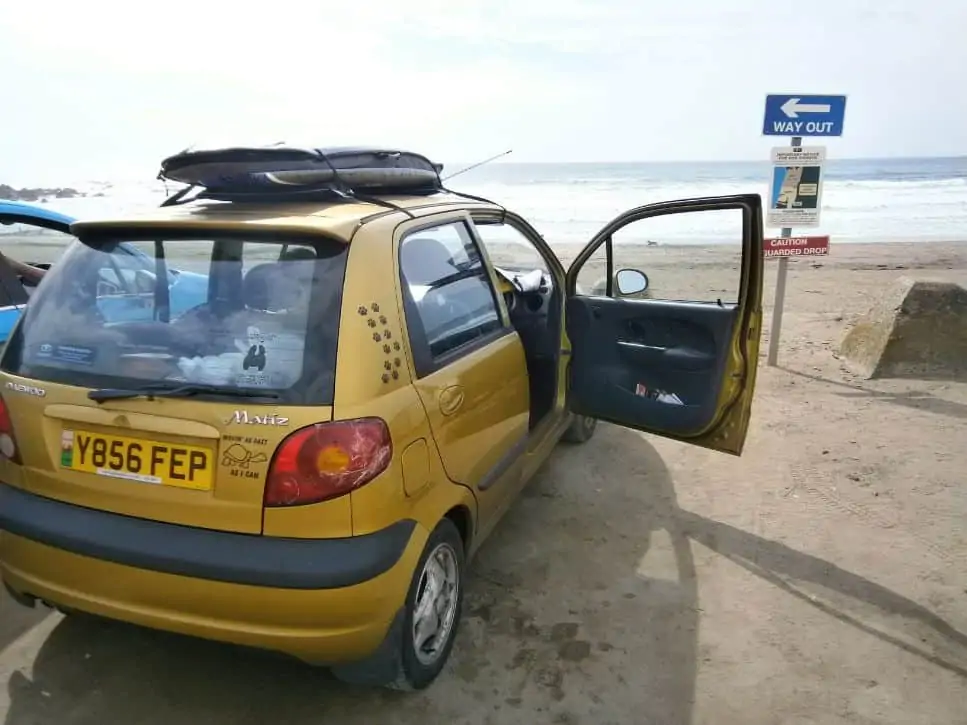
Cross Bar or Soft Racks for Surfers
Personally, I prefer soft surfboard racks since they are made for surfboards and offer a bit more padding, as well as looping through the inside of your car.
This inside looping system lets you check the tension while driving and also means that your boards are flat on the roof of your car.
With the boards being flat on the roof and that much closer to you, you can see them either when driving or as the passenger to check on how the boards are doing.
However, if you want to carry heavier boards, like longboards and even stand-up paddleboards (SUPs), then cross bar racks are the better option since they handle heavier loads and are more sturdy.
It really comes down to your chosen surfboard type and how often you will be using it, since crossbar racks are a more permanent option while softracks are better if you will be taking them on and off frequently, or if the car is not yours and you are getting lifts to the beach.
How to carry two or more surfboards on a roof rack?
You can carry several surfboards on a roof, but remember that the more you carry, the more difficult it will be.
Make sure that you stack the boards on the roof in height order, starting with the biggest board on the bottom and smallest on top.
Note that your surfboards will then naturally push further forward with each board you add on top.
It’s probably a good idea not to add more than 3 surfboards on top of each other on your roof racks.
You can also fit a second ‘stack’ of surfboards on the roof if you strap each stack to the far side of the roof rack system that you have.
In the case of soft rack systems, you will need to buy a ‘double’ set to be able to do this and the instructions will tell you how many surfboards you can carry at one time; this will usually be anywhere from 4-6 surfboards depending on how strong the system is, with either 2 or 3 boards in each stack.
When using standard tiedown straps on a cross bar roof rack with two or more surfboards, make sure that you have enough strap left to be able to pull it through the camlock buckle tightly. You should also have enough left over to tie the ends of the straps to be sure that they don’t slip or come undone.
If you load up too much and push this too far, you might find that you can’t tighten the buckle enough, risking losing your boards on the road and putting other road users at serious risk.
Do you need a surfboard bag on a roof rack?
You should always put a surfboard in a bag on a roof rack to protect the board from damage. A surfboard bag is padded and offers protection from the tiedown straps that you will need to use. If you don’t use a board bag, the rails on your surfboard can easily get dinged or cracked after a ride to the beach with them on the roof of your car.
For the easiest option, get yourself a good ‘day bag’ as these are light enough to take to the beach every day but also provide enough padding and protection to keep your board safe while on the roof of your car.
That said, you can easily use a heavy duty travel bag, but they are that little bit more bulky than a day bag, making them a bit more of a drag to carry with you day to day.
How do you lock a surfboard to a roof rack?
To lock your board, the best way to do this is to get yourself some lockable tiedown straps.
As you will need to get tiedown straps for most roof rack systems anyway, it’s worth spending the extra few bucks to get straps that can be locked.
This is because countless surfers and board riders have had their precious (and expensive!) boards stolen from their roof when they head into a store for a few minutes. It only takes an opportunist with a knife and a van to steal your boards, so play it safe on this front!
Things to Remember
Having had quite a few experiences with surfboard racks over the years, I wanted to add some tips for carrying your board to and from the beach on your roof safely.
Speed
Avoid going too fast when riding with surfboards on your roof. Most roof rack systems will come with a speed limit warning, and this includes soft rack surfboards.
70mph (or 113kmh) is the maximum speed for carrying surfboards on the roof of your car, as stated by manufacturers like Creatures of Leisure on their roof rack products. Going >70mph with boards on the roof risks the racks breaking, causing a serious hazard to other road users and damaging boards.
This is because your surfboard will cause a lift force on your roof rack system when traveling at speed and they can come off if you break the recommended speed limit.
I say this from experience since I was traveling behind friends driving at 80mph (130kmh~) who had permanent metal roof racks on the top of his car with a surfboard attached.
Suddenly, the front cross bar of their roof rack lifted off, pulling the gigantic 8 foot long surfboard with it.
Fortunately, I was driving behind at enough of a distance to be able to avoid it, but it is an image that has stayed with me since I did feel something of my life flashing before my eyes as I swerved and heard the trucker next to me honking his horn like crazy.
I don’t know what might have happened had I been much closer to them and with heavier traffic.
In short, don’t make the same mistake as my friends and always stay well under the recommended speed limit for carrying surfboards!
Noise
Carrying surfboards on your car roof will also make a strange noise. You will hear a humming sound as the straps vibrate at high speeds.
You can try to twist some of the straps on the outside to reduce this noise but you might not be able to avoid it.
Either way, having the noise from your tiedown straps is actually quite helpful as know that your boards are still there and that the straps are still tight. If you hear a definite change in this sound, then it would be a good idea to stop and check to see if all is good.
Possible damage
The other thing that you will want to avoid with your surfboard roof racks is causing damage to your surfboards.
As mentioned earlier in this post, you might find that your surfboard rails get cracks in them or even dinged if you try to tighten the straps too much.
This is where using a bag is crucial, as is experience. You can usually judge how tight the boards need to be from giving them a good push before you set off.
Remember that it is fine for them to rock from side to side, but they should not move up and down from the front since this could cause them to flap up and down while you drive, making a noise and possibly loosening or damaging your boards.
Carrying your surfboard in a bag on top of your car will mean that you are able to put the straps tighter with less chance of hurting your board, so a win-win situation.
Related Questions
Can you carry a surfboard on a car roof without racks? Yes, you can carry a surfboard on the roof of the car without roof racks. You will need some EVA foam pads and get camlock tiedowns that are similar to those used on roof racks. You can see more on this in the video below.
In essence, it is a quick and easy way to make a set of soft racks, so although they aren’t actually roof racks, they look very similar.
Is it bad to leave a surfboard in the car? Yes because cars can heat up quickly inside and that can damage your surfboard quite quickly. This can cause your board to have a heat bubble which could lead to delamination, which is expensive and hard to fix.
The wax on your surfboard will also melt quickly if you leave it in your car, causing a mess and meaning that you will need to wax your board again, which is a hassle that you don’t need. It might also mean that you need to clean the upholstery on your car since wax is pretty nasty once it gets onto your car seats and interior!
If you must leave a surfboard in your car, then at least leave the windows open to allow for some air to circulate and keep the car’s temperature down a little. Also don’t leave your surfboard for long since having the windows open means it is easier for people to try and break into your car, so the less time you leave the board the better.
Will a surfboard fit in my car? Probably yes – although it depends on the size of your car. Most surfboards up to about 8 feet in length will fit into even the smallest of cars if you place them on the front passenger seat (lay this flat).
The main problem with putting bigger surfboards in your car is that they are wider and can cause problems for the driver. This can be things like affecting stick shift gear changes, as well as the hand brake, so be careful with these longer surfboards in your car.


